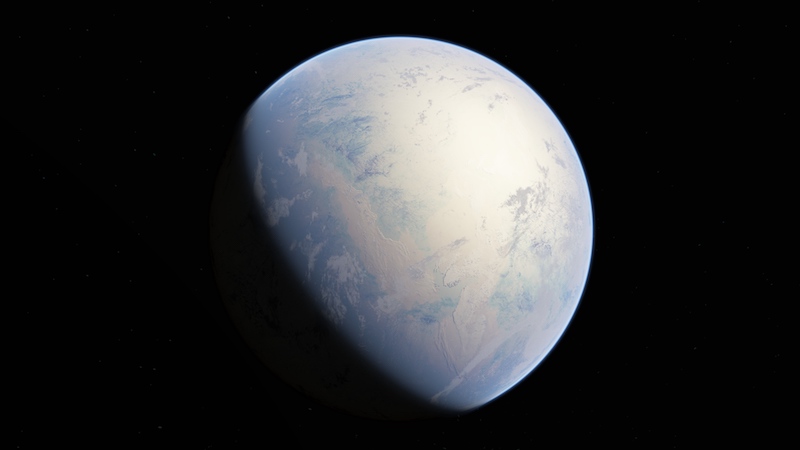
- Carbon dioxide (CO2) is a greenhouse gas. More in the atmosphere warms the planet. Less makes Earth colder. Scientists believe low CO2 levels led to a complete glaciation of Earth about 700 million years ago. Scientists call this hypothetical global ice age a Snowball Earth.
- The new research suggests a double climate whammy that caused Snowball Earth. First, plate tectonics brought volcanic degassing of atmospheric CO2 to a minimum. At the same time, a continental volcanic province in Canada started eroding away, consuming atmospheric CO2. At that point, glaciation kicked in.
- The changes that led to Snowball Earth took millions of years. Still, studies of those changes can help us comprehend human-induced climate change, these scientists said, which is happening at a pace 10 times faster than any change we have seen before.
Lack of CO2 made the Earth freeze over
Glaciers have advanced and retreated several times during Earth’s long history. But at least once – during the aptly named Cryogenian period, some 700 million years ago – the ice is believed to have covered our planet from pole to pole. Scientists call this time in Earth’s history Snowball Earth. And they’ve tried to explain why so much ice formed.
Using a computer model of Earth’s ancient tectonic plate movement, a group of researchers at the University of Sydney in Australia now think they have the answer. They think they know why miles of ice covered the entire surface of Snowball Earth. Their work shows that the likely culprit was a severe drop in the greenhouse gas carbon dioxide.
Lead researcher Adriana Dutkiewicz described what made the Earth ice over during the Sturtian glaciation (about 717-660 million years ago) in a news release:
We now think we have cracked the mystery: historically low volcanic carbon dioxide emissions, aided by weathering of a large pile of volcanic rocks in what is now Canada … a process that absorbs atmospheric carbon dioxide.
Dutkiewicz and co-author Alan Collins conducted field research in the Flinders Ranges of South Australia and fed their findings into EarthByte, a four-dimensional model of the Earth. They looked not just for the reason ice coated the planet, but also why the extreme cold lasted so long, around 57 million years.
The Geological Society of America published the paper detailing their findings on February 7, 2024.
No plants, no animals. Geology ruled when the ice took over
Dutkiewicz and company knew the cause of Snowball Earth had to be geological. She said:
At this time, there were no multicellular animals or land plants on Earth. The greenhouse gas concentration of the atmosphere was almost entirely dictated by CO2 outgassing from volcanoes and by silicate rock weathering processes, which consume CO2.
While plate tectonics had been suspected to be involved, the researchers had another clue: extremely low levels of carbon dioxide. Co-author Dietmar Müller described what happened so long ago:
Geology ruled climate at this time. We think the Sturtian ice age kicked in due to a double whammy: a plate tectonic reorganization brought volcanic degassing to a minimum, while simultaneously a continental volcanic province in Canada started eroding away, consuming atmospheric CO2. The result was that atmospheric CO2 fell to a level where glaciation kicks in, which we estimate to be below 200 parts per million, less than half today’s level.
Their theory was inspired by studying the debris left by ancient glaciers in the Flinders Ranges of South Australia.
Will the Earth freeze or fry in the future?
Changes to Earth of this scale happen very slowly, over millions of years. Now that we understand the process that led to Snowball Earth, we can use this knowledge to predict Earth’s far future, or at least imagine it how it might progress.
According to the current modeling, it seems as if mammals – which have roamed the planet for 55 million years – might be doomed when the next supercontinent forms in about a quarter of a billion years. If and when Pangea Ultima forms, theory holds it will be too hot for our form of life.
But with our new understanding of how Earth ices over, it could also be that when that new supercontinent forms, the lack of tectonic activity and resulting volcanism will drive down CO2 levels and save the day. Or not. The future, as always, is uncertain, Müller noted:
Whatever the future holds, it is important to note that geological climate change, of the type studied here, happens extremely slowly. According to NASA, human-induced climate change is happening at a pace 10 times faster than we have seen before.
Bottom line: Geologists at the University of Sydney in Australia believe a drop in carbon dioxide lasting millions of years caused Earth to freeze into Snowball Earth about 700 million years ago.











